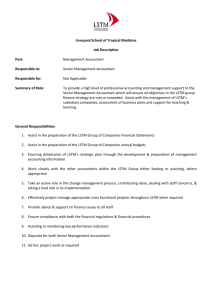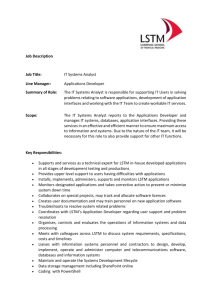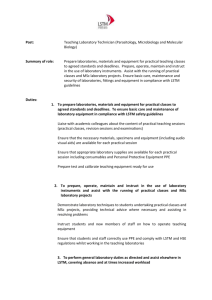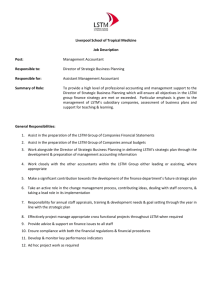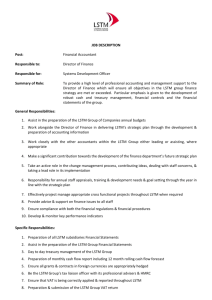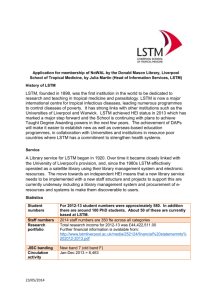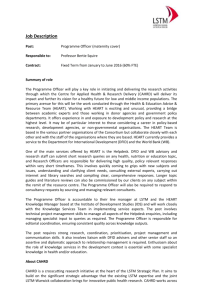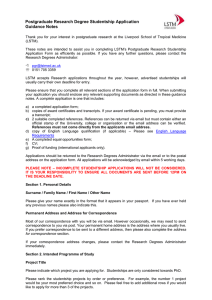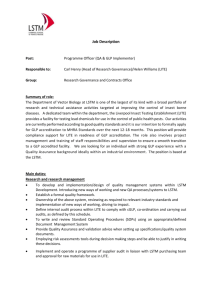lstm - Deep Learning
advertisement
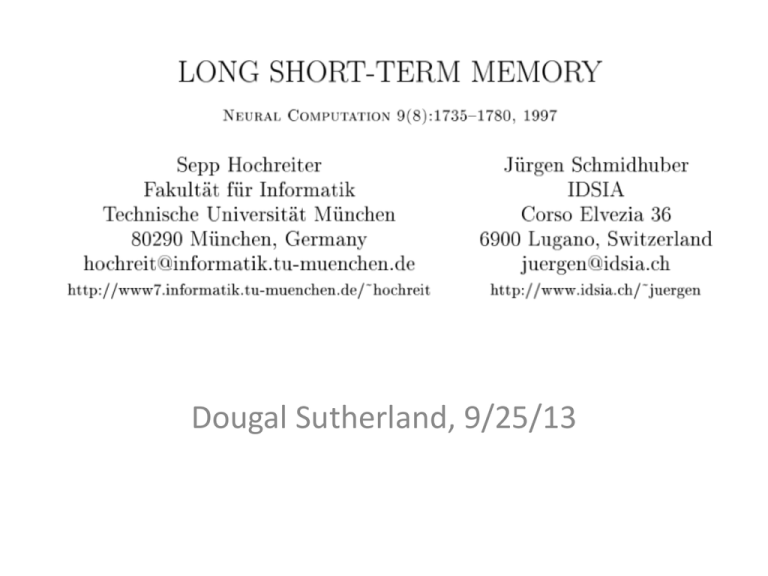
Dougal Sutherland, 9/25/13
Problem with regular RNNs
• The standard learning algorithms for RNNs
don’t allow for long time lags
• Problem: error signals going “back in time” in
BPTT, RTRL, etc either exponentially blow up
or (usually) exponentially vanish
• The toy problems solved in other papers are
often solved faster by randomly guessing
weights
Exponential decay of error signals
Error from unit u, at step t, to unit v, q steps prior, is
scaled by
Summing over a path with lq=v, l0=u:
if always > 1: exponential blow-up in q
if always < 1: exponential decay in q
Exponential decay of error signals
• For logistic activation, f’(.) has maximum ¼.
• For constant activation, term is maximized with
• If weights have magnitude < 4, we get
exponential decay.
• If weights are big, the derivative gets bigger
faster and error still vanishes.
• Larger learning rate doesn’t help either.
Global error
• If we sum the exponential decay across all
units, we see will still get vanishing global
error
• Can also derive a (very) loose upper bound:
– If max weight < 4/n, get exponential decay.
– In practice, should happen much more often.
Constant error flow
• How can we avoid exponential decay?
• Need
• So we need a linear activation function, with
constant activation over time
– Here, use the identity function with unit weight.
• Call it the Constant Error Carrousel (CEC)
CEC issues
• Input weight conflict
– Say we have a single outside input i
– If it helps to turn on unit j and keep it active, wji
will want to both:
• Store the input (switching on j)
• Protect the input (prevent j from being switched off)
– Conflict makes learning hard
– Solution: add an “input gate” to protect the CEC
from irrelevant inputs
CEC issues
• Output weight conflict
– Say we have a single outside output k
– wkj needs to both:
• Sometimes get the output from the CEC j
• Sometimes prevent j from messing with k
– Conflict makes learning hard
– Solution: add an “output gate” to control when
the stored data is read
LSTM memory cell
LSTM
• Later on, added a “forget gate” to cells
• Can connect cells into a memory block
– Same input/output gates for multiple memory cells
• Here, used one fully-connected hidden layer
– Consisting of memory blocks only
– Could use regular hidden units also
• Learn with a variant of RTRL
– Only propagates errors back in time in memory cells
– O(# weights) update cost
LSTM topology example
Issues
• Sometimes memory cells get abused to work
as constant biases
– One solution: sequential construction. (Train until
error stops decreasing; then add a memory cell.)
– Another: output gate bias. (Initially suppress the
outputs to make the abuse state farther away.)
Issues
• Internal state drift
– If inputs are mostly the same sign, memory
contents will tend to drift over time
– Causes gradient to vanish
– Simple solution: initial bias on input gates towards
zero
Experiment 1
Experiment 2a
• One-hot coding of p+1 symbols
• Task: predict the next symbol
• Train: (p+1, 1, 2, …, p-1, p+1), (p, 1, 2, …, p-1, p)
– 5 million examples, equal probability
•
•
•
•
Test on same set
RTRL usually works with p=4, never with p=10
Even with p=100, LSTM always works
Hierarchical chunker also works
Experiment 2b
• Replace (1, 2, …, p-1) with random sequence
– {x, *, *, …, *, x} vs {y, *, *, …, *, y}
• LSTM still works, chunker breaks
Experiment 2c
• ?????????
Experiment 3a
• So far, noise has been on separate channel from
signal
• Now mix it:
– {1, N(0, .2), N(0, .2), …, 1} vs {-1 , N(0, .2), …, 0}
– {1, 1, 1, N(0, .2), …, 1} vs {-1, -1, -1, N(0, .2), …, 0}
• LSTM works okay, but random guessing is better
Experiment 3b
• Same as before, but add Gaussian noise to the
initial informative elements
• LSTM still works (as does random guessing)
Experiment 3c
• Replace informative elements with .2, .8
• Add Gaussian noise to targets
• LSTM works, random guessing doesn’t
Experiment 4
• Each sequence element is a pair of inputs: a
number [-1, 1] and one of {-1, 0, 1}
– Mark two elements with a 1 second entry
– First, last elements get a -1 second entry
– Rest are 0
– Last element of sequence is sum of the two
marked elements (scaled to [0, 1])
• LSTM always learns it with 2 memory cells
Experiment 5
• Same as experiment 4, but multiplies instead
of adds
• LSTM always learns it with 2 memory cells
Experiment 6
• 6a: one-hot encoding of sequence classes
– E, noise, X1, noise, X2, noise, B, output
• X1, X2 each have two possible values
– Noise is random length; separation ~40
– Output is different symbol for each X1, X2 pair
• 6b: same thing but X1, X2, X3 (8 classes)
• LSTM almost always learns both sequences
– 2 or 3 cell blocks, of size 2
Problems
• Truncated backprop doesn’t work for e.g.
delayed XOR
• Adds gate units (not a big deal)
• Hard to do exact counting
– Except Gers (2001) figured it out: can make sharp
spikes every n steps
• Basically acts like feedforward net that sees
the whole sequence at once
Good things
• Basically acts like feedforward net that sees
the whole sequence at once
• Handles long time lags
• Handles noise, continuous representations,
discrete representations
• Works well without much parameter tuning
(on these toy problems)
• Fast learning algorithm
Cool results since initial paper
• Combined with Kalman filters, can learn AnBnCn
for n up to 22 million (Perez 2002)
• Learn blues form (Eck 2002)
• Metalearning: learns to learn quadratic functions
v. quickly (Hochreiter 2001)
• Use in reinforcement learning (Bakker 2002)
• Bidirectional extension (Graves 2005)
• Best results in handwriting recognition as of 2009
